Magritte the Dominion of Light Musees Royaux Des Beauxarts De Belgique
| The Empire of Light (Cycle) | |
|---|---|
| French: 50'Empire des lumières | |
 The Empire of Lite (1954), Musées Royaux des Beaux-Arts de Belgique, Brussels | |
| Creative person | René Magritte |
| Year | circa 1939 – 1967 |
| Medium | Oil on canvas and gouache on paper |
| Movement | Surrealism |
| Location | Museum Boijmans Van Beuningen, Museum of Mod Art, Peggy Guggenheim Collection, The Menil Collection, Musées Royaux des Beaux-Arts de Belgique, Magritte Museum, and diverse private collections |
The Empire of Light (French: L'Empire des lumières) is the title of a succession of paintings past René Magritte.[1] They depict the paradoxical image of a nocturnal landscape beneath a sunlit heaven.[2] He explored the theme in 27 paintings (17 oil paintings and 10 gouaches) from the 1940s to the 1960s.[iii] [4] The paintings were not planned as a formal series. They have never all been exhibited together and are rarely exhibited in smaller groups.[1] [4] The original French championship, L'Empire des Lumieres is sometimes translated as singular, The Empire of Light,[five] : 60 p. [six] : 184 p. and sometimes as plural The Empire of Lights.[7] : 126 p. [8] : 177 p. Other translations include The Dominion of Light: making the distinction: "an empire exists in relation to a ruler, a dominion does not necessarily crave this."[iv]
Precursors, influences, and origins [edit]
Ane source states the artist was inspired past the works of John Atkinson Grimshaw, an English painter from the Victorian era, who had delighted in his time to paint urban views at dusk.[ix] More than perceptively, other sources identify the nocturnal paintings past the Belgian symbolist William Degouve de Nuncques (1867 – 1935) as an influence on Magritte'due south series, specifically his painting The Blind House.[10] : 65 p. [7] : 126 p. The art historian and quondam manager of the Kröller-Müller Museum in holland, A. Grand . Hammacher also observed that Magritte was "highly interested" in the landscapes of the bully German romantic painter Caspar David Friedrich.[7] : 126 p. William Rubin made comparisons between some of Max Ernst'southward frottage paintings, specifically Woods [(1927), oil on canvas 114 ten 146 cm. in Joseph Slifka drove, New York at that time], commenting of Ernst's painting "the night landscape enigmatically includes a brilliant daylight sky (Magritte was to explore this aforementioned conjunction later in The Empire of Light II)."[half-dozen] : 182-184 p. Comparisons with Salvador Dali'due south gouache Night and Day Clothes (1936) and Max Ernst's 24-hour interval and Night (1941–42) in the Menil Collection are also intriguing.[3]
An early example of Magritte playing with the idea of the simultaneous appearance of dark and day is a gouache painted in 1939 that is now in the Museum Boijmans Van Beuningen, Rotterdam. In this gouache, the horizon of a twilight heaven is sharply lit by a sunset casting a grouping of trees and houses in the foreground in a black silhouette which is filled with stars and a crescent moon. A volume on Magritte published in 1973 identifies the gouache as La Bonne Aventure (Good Fortune),[vii] : 126-127 p. nonetheless the website of the Museum Boijmans Van Beuningen gives the title every bit Le poison (The Poison) and states it is the commencement in the serial The Empire of Lite.[3]
The series [edit]
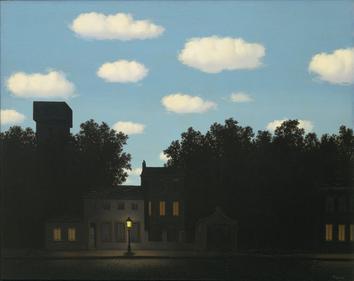
The Empire of Light 2 (1950), oil on canvas, 79 10 99 cm. Museum of Modern Fine art, New York
Although Magritte had already completed a few versions by 1953, a retrospective at the 1954 Venice Biennale included a 1954 version (now in the Peggy Guggenheim Collection) that attracted several collectors with expectations of buying the painting. Magritte ended up producing multiple large, high quality versions that year to satisfy the collectors, and he connected to occasionally explore the theme in paintings for the rest of his life.[4]
The motif was included in the designs for a serial of murals in the chief gaming room at the Municipal Casino at Knokke-Le Zoute in Kingdom of belgium. Titled The Enchanted Domain, Magritte produced a ready of eight easel sized paintings reprising and intergrading numerous themes that had appeared in his previous work. His paintings were then copied to the walls on a 1:half-dozen scale, in a 360-degree panorama (236 ft., 71.93 m. circumference), under his supervision and completed in 1953.[i] [7] : 57-59 pp.
Another painting from 1958, in which Magritte switched the lighting, with a sunlit landscape nether a nighttime heaven is Le salon de Dieu (God'southward Cartoon Room), oil on sheet, 43 x 59 cm., (in the individual collection of Arnold Weissberger, New York in 1977). Magritte discussed the painting in an undated letter to Suzi Gablik stating: "I'd similar to tell you I've brought off a very difficult picture, only which is probably also difficult to be successful? Information technology involves a painting of a daylit landscape with a nocturnal sky (stars and crescent moon). I've painted and repainted this picture and I'm at the disenchanted stage, It's a total failure! A friend found equally championship Le salon de Dieu (God's Drawing Room): I hesitated a long time in adopting information technology; a championship such every bit Le bal masqué (The Masked Ball) seemed preferable to me for many reasons, the main one being the total ban on proverb anything at all about God. But to run into information technology and reproduce it in paint is possible only if one is a God. While waiting to go ane, I'grand abandoning the project."[8] : 179 p.
Quotes from the artist and André Breton [edit]
Magritte commented on the paintings in a televised interview in 1956, about the time he received his Guggenheim Prize.[8] : 177 p. [3]
For me, the conception of a painting is an idea of one thing or several things that can become visible through my painting. It is understood that all ideas are not conceptions for pictures. Patently, an idea must be sufficiently stimulating for me to undertake to paint faithfully the thing or things I have ideated.
The conception of a picture show, that is, the idea, is not visible in the picture: an idea cannot exist seen with the optics. What is represented in a picture is what is visible to the optics, it is the matter or things that must have been ideated. Thus, what are represented in the picture show The Empire of Light are the things I ideated, i.due east. a nighttime landscape and a heaven such as we meet during the 24-hour interval. The landscape evokes night and the sky evokes day. I phone call this power: poetry.
If I believe this evocation has such poetic power, it is because among other reasons, I accept e'er felt the greatest interest in night and in day, yet without ever having preferred ane or the other. This great personal interest in night and day is a feeling of admiration and astonishment."[8] : 177 p.
In 1964, John and Dominique de Menil organized an exhibition of Magritte's work in Houston, Texas. The Belgian surrealist attended the exhibit, replete in an incongruous cowboy chapeau and boots. André Breton wrote the introduction for the exhibition catalogue and commented on the 'Empire of Light paintings.[xi]
"Rene Magritte'due south work and thought could not fail to come up out at the reverse pole from the zone of facility - and of capitulation - that goes past the name of "chiaroscuro." To him, inevitably, savage the task of separating the "subtle" from the "dense", without which endeavour no transmutation is possible. To attack this trouble called for all his audacity - to extract simultaneously what is light from the shadow and what is shadow from the low-cal (50'Empire des Lumieres). In this work the violence done to accustomed ideas and conventions is such (I - Breton - have this from Magritte) that near of those who go by quickly think they saw the stars in the daytime heaven."[xi] : 7 p.
[edit]

The Empire of Lite (1954), oil on sheet, 195.4 x 131.2 cm., Peggy Guggenheim Drove, Venice
- Expert Fortune [7] : 126-127 pp. or The Poison [iii] (1939), gouache, 33.6 10 40.6 cm., Museum Boijmans Van Beuningen, Rotterdam.
- The Empire of Low-cal (1948), 100 10 fourscore cm., private collection, Brussels, Belgium*
- The Empire of Calorie-free II (1950), 79 x 99 cm. Museum of Modern Art, New York, New York (Gift of the Menils)
- The Empire of Light III (1951), 78.7 x 66 cm., William Alexander, New York, New York*
- The Empire of Light (1953), 37 10 45 cm. Arnold Weissberger, New York, New York*
- The Empire of Light (1954), 195.iv x 131.two cm., Peggy Guggenheim Collection, Venice, Italy
- The Empire of Light Eight (1954), 129.ix x 94.half-dozen cm., The Menil Collection, Houston, Texas
- The Empire of Light (1954), 146 x 114 cm., Musées Royaux des Beaux-Arts de Belgique, Brussels, Belgium
- The Empire of Light (1958), 49.5 x 39.5 cm., New York, New York*
- God'southward Drawing Room (1958), 43 10 59 cm., Arnold Weissberger, New York*
- The Empire of Low-cal (1961), 114 x 146 cm., private collection, Brussels, Belgium*
- The Empire of Light (no date), private collection, Brussels, Belgium*
- The Empire of Lite (1967, unfinished), 45 10 50 cm., Magritte Museum, Brussels, Belgium
All works are oil on sheet unless noted otherwise. An asterisk (*) indicates the collection based on a 1977 publication and may not reflect the current collection.[8] : 177–181
Legacy, influences, and trivia [edit]
The paintings inspired a scene in the 1973 horror film The Exorcist, which was used on the film's posters and habitation video releases, in which the graphic symbol Father Merrin stands in front of the MacNeil family's business firm.[12] [13] It as well inspired the artwork for the comprehend of Jackson Browne's 1974 anthology Belatedly for the Heaven.[14]
Gallery of comparative paintings [edit]
-
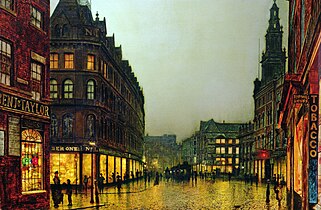
John Atkinson Grimshaw, Boar Lane, Leeds, 1880s
-
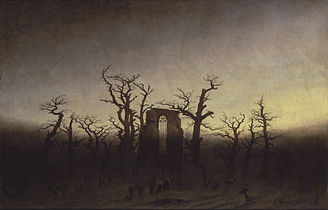
Caspar David Friedrich, Abbey in the Oakwood (1809-x), oil on canvas, 171 x 110.iv cm., Alte Nationalgalerie, Berlin
-
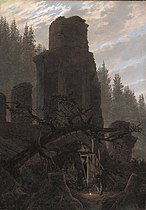
Caspar David Friedrich, Church building ruin in the forest (c. 1831), oil on canvas, 70.5 ten 49.7 cm., Neue Pinakothek, Munich
-
William Degouve de Nuncques, The Blind Firm (1892), oil on sheet, Kröller-Müller Museum, Otterlo
-

William Degouve de Nuncques, The Canal (1894), oil on canvas, 42,four x 122,5 cm., Kröller-Müller Museum, Otterlo
Meet also [edit]
- 100 Peachy Paintings, 1980 BBC serial
References [edit]
- ^ a b c Kantrowitz, Jonathan (25 November 2017), René Magritte: The Fifth Season. Fine art History News. (accessed 19 Dec 2020)
- ^ "The Empire of Lights also known as 50'Empire des Lumieres". Aaron Art Prints. Retrieved xxx May 2014.
- ^ a b c d e Peyser, Marijke. Museum Boijmans Van Beuningen, Rotterdam: A dream collection - Surrealism in Museum Boijmans Van Beuningen (accessed 19 December 2020)
- ^ a b c d Zivkovic, Alex (2018), "'It'due south Similar Being in the Picture': The Dominion of Light at SFMOMA". San Francisco Museum of Modern Art (accessed 19 December 2020)
- ^ Noël, Bernard (1977), Magritte. Crown Publishers, Inc. New York. 96 pp. ISBN 0-517-53009-0
- ^ a b Rubin, William S. (1968) Dada and Surrealist Art. Harry Northward. Abrams, Inc., Publishers, New York. 525 pp.
- ^ a b c d east f Hammacher, A. One thousand. (1973) Magritte. The Library of Corking Painters. Harry N. Abrams, Inc., Publishers, New York, 167 pp. ISBN 0-8109-0278-eight
- ^ a b c d e Torczyner, Harry (1977) Magritte: Ideas and Images. Harry N. Abrams, Inc., Publishers, New York, 277 pp. ISBN 0-8109-1300-3
- ^ Federico Zeri, Un velo di silenzio, Milano, 1999, pp. 229-230
- ^ Cassou, Jean (1984) The Concise Encyclopaedia of Symbolism. Chartwell Books, Inc. Secaucus, New Jersey. 292 pp. ISBN 0-89009-706-2
- ^ a b Breton, André (1964), The Latitude of Rene Magitte, 5-7 pp. In Magritte. The Art Department of the University of St. Thomas, Houston Texas. 36 pp. [translated by W. G. Ryan]
- ^ "25 Fascinating Facts About The Exorcist". Listverse. xxx October 2009. Retrieved 29 May 2014.
- ^ "26 Fascinating Facts About The Exorcist". Mental Floss. 26 December 2018. Retrieved 31 May 2014.
- ^ Jackson Browne's Late For The Heaven - The Design of a Classic Album Cover, archived from the original on 10 October 2012, retrieved 12 Feb 2022
External links [edit]
- Guggenheim website catalog entry
- Museum of Mod Art website catalog entry
- Purple Museums of Fine Arts of Kingdom of belgium website catalog entry
- An interactive soundscape (MusIcon) of the painting.
Source: https://en.wikipedia.org/wiki/The_Empire_of_Light
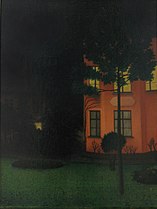
0 Response to "Magritte the Dominion of Light Musees Royaux Des Beauxarts De Belgique"
Post a Comment